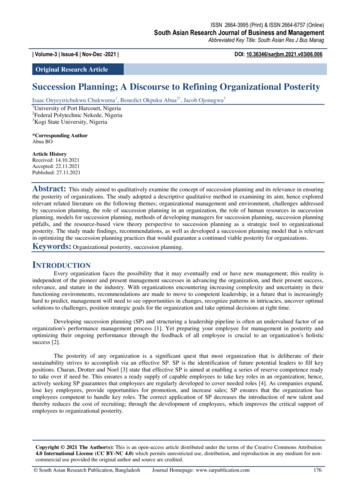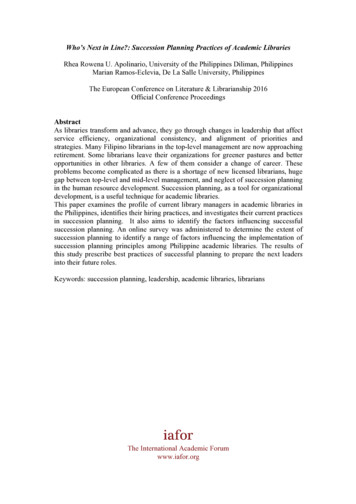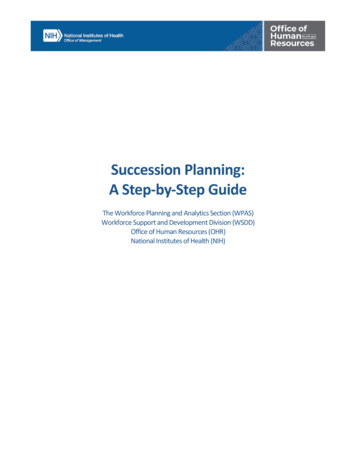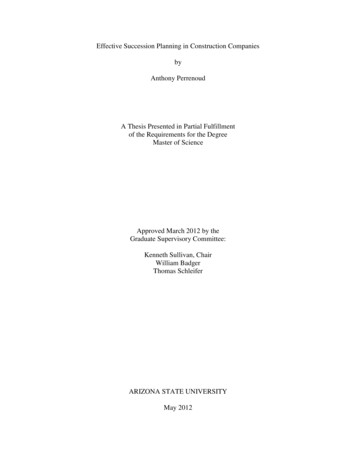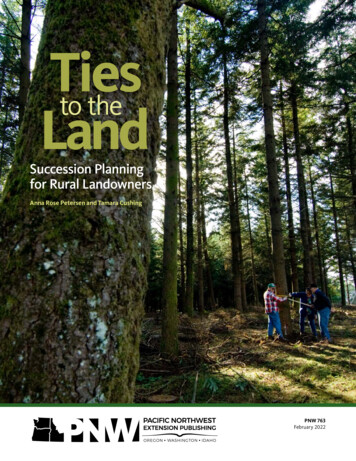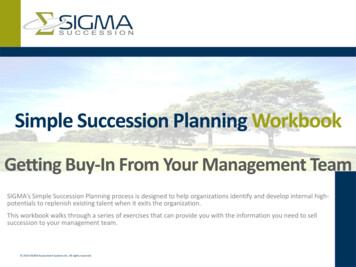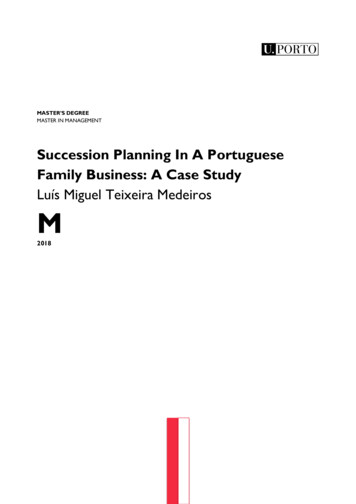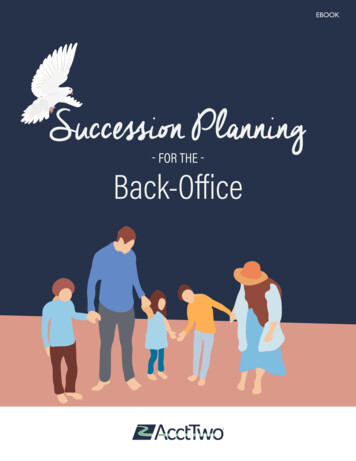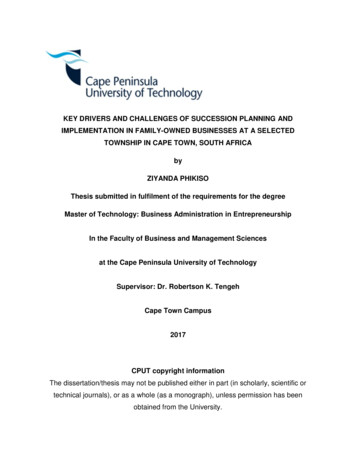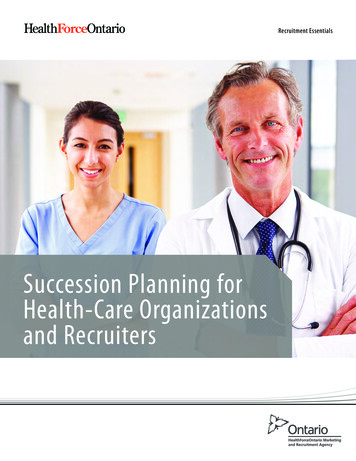
Transcription
Recruitment EssentialsSuccession Planning forHealth-Care Organizationsand Recruiters
Recruitment Essentials Succession Planning for Health-Care Organizations and RecruitersTable of contentsI. Introduction. . . . . . . . . . . . . . . . . . . . . . . . . . . . . . . . . . . . . . . . . . . . . . . . . . . . . . . . . . . . . . . . . . 1II. Succession Planning Framework. . . . . . . . . . . . . . . . . . . . . . . . . . . . . . . . . . . . . . . . . . . . . 31. Develop a Picture of the Local Physician Human ResourcesNeeds Now and into the Future . . . . . . . . . . . . . . . . . . . . . . . . . . . . . . . . . . . . . . . . . . . . . . . . . . . . . . 4A. Develop a Business Case . . . . . . . . . . . . . . . . . . . . . . . . . . . . . . . . . . . . . . . . . . . . . . . . . . . 4B. Conduct an Environmental Scan. . . . . . . . . . . . . . . . . . . . . . . . . . . . . . . . . . . . . . . . . . . . . 5C. Prioritize the Needs . . . . . . . . . . . . . . . . . . . . . . . . . . . . . . . . . . . . . . . . . . . . . . . . . . . . . . . 82. Create and Execute a Plan. . . . . . . . . . . . . . . . . . . . . . . . . . . . . . . . . . . . . . . . . . . . . . . . . . . . . . . . . . . 8D. Engage Stakeholders. . . . . . . . . . . . . . . . . . . . . . . . . . . . . . . . . . . . . . . . . . . . . . . . . . . . . . 8E. Begin the Recruitment Process. . . . . . . . . . . . . . . . . . . . . . . . . . . . . . . . . . . . . . . . . . . . . . 9F. Consider a Legal Agreement. . . . . . . . . . . . . . . . . . . . . . . . . . . . . . . . . . . . . . . . . . . . . . . . 9G. Establish and Implement Transition and Retention Best Practices . . . . . . . . . . . . . . . . . 10H. Create a Contingency Plan. . . . . . . . . . . . . . . . . . . . . . . . . . . . . . . . . . . . . . . . . . . . . . . . . . 11III. Conclusion. . . . . . . . . . . . . . . . . . . . . . . . . . . . . . . . . . . . . . . . . . . . . . . . . . . . . . . . . . . . . . . . . . . . 13IV. Tools and Templates. . . . . . . . . . . . . . . . . . . . . . . . . . . . . . . . . . . . . . . . . . . . . . . . . . . . . . . . . . 14A. Succession Planning Framework. . . . . . . . . . . . . . . . . . . . . . . . . . . . . . . . . . . . . . . . . . . . . 15B. Business Case Template. . . . . . . . . . . . . . . . . . . . . . . . . . . . . . . . . . . . . . . . . . . . . . . . . . . . 16C. Templates for Medical Staff Succession Planning Survey. . . . . . . . . . . . . . . . . . . . . . . . . 18i. Medical Resources Succession Planning Survey . . . . . . . . . . . . . . . . . . . . . . . . . 18– Survey Introduction Letterii. Medical Resources Succession Planning Survey . . . . . . . . . . . . . . . . . . . . . . . . . 19– Individual Physiciansiii. Medical Resources Succession Planning Survey . . . . . . . . . . . . . . . . . . . . . . . . . 19– Clinics/Practices in a Community or RegionD. Physician HR Planner Template (Excel). . . . . . . . . . . . . . . . . . . . . . . . . . . . . . . . . . . . . . . .20E. 9-Box Tool (Excel). . . . . . . . . . . . . . . . . . . . . . . . . . . . . . . . . . . . . . . . . . . . . . . . . . . . . . . . . 21F. Physician Pipeline MAP Template (Excel). . . . . . . . . . . . . . . . . . . . . . . . . . . . . . . . . . . . . . 22G. Succession Planning — Physician Interview Guide. . . . . . . . . . . . . . . . . . . . . . . . . . . . . 23H. Practice Transition Checklist . . . . . . . . . . . . . . . . . . . . . . . . . . . . . . . . . . . . . . . . . . . . . . . . 24
Recruitment Essentials Succession Planning for Health-Care Organizations and RecruitersI. IntroductionSuccession planning for physicians is a dynamic, ongoing process, which supports the continuity of patient care and is an important element of anoverall recruitment strategy. This module has been written to provide health-care organizations and community recruiters with a toolkit to addressneeds that arise when physicians transition out of practice. The guide will help organizations and recruiters develop a picture of local physicianhuman resources needs now and into the future, and create and execute a plan to address those needs.Physician human resources planning includes well developed strategies for all of a physician’s career stages: education and training, transition intopractice, practice maturity and continuing education, and winding down and/or retiring.Education and TrainingTransition into PracticePractice Maturity andContinuing EducationWinding Downand/or Retirement1
Recruitment Essentials Succession Planning for Health-Care Organizations and RecruitersWhat is succession planning?Succession planning1 is commonly defined as the set of processesto identify and develop potential successors for key positions in anorganization, through a systematic evaluation process and developmentplans. Physicians are independent professionals, therefore it’s importantto consider succession planning in the health-care context as a processthat relates to the many different physicians who are serving patientsin a community across various organizations/groups.For the purposes of this module, succession planning is defined asa set of processes or activities that accomplish two tasks:1. Develop a picture of the local physician human resourcesneeds now and into the future2. Create and execute the plan to address those needs.Physician succession planning activities include: Recruitment planning - finding replacement physicians to fillthe service gap that will result from a retirement Retention planning - enabling later career physicians to sharetheir expertise and mentor early career physicians Retirement planning – supporting later career physicians asthey decrease their practice and reduce their workload.A succession plan is valuable because it: Looks into the future to determine recruitment needs Minimizes risks often associated with physicians leavingan active practice Draws upon the valuable contributions a physician makes tohealth-care delivery.Establishing plans to ensure the physician complement can meetor enhance service demands in a particular region/community/organization is key to ongoing access to care.Succession planning definition adapted from resources provided by the Human Resources Professionals Association (HRPA) Workshop: Building Success with Succession Planning byAlan Ward (January 2015) and the HR Council of Canada – Succession Planning – on-line Toolkit.12
Recruitment Essentials Succession Planning for Health-Care Organizations and RecruitersII. Succession Planning FrameworkSuccession planning processes and activities can be depicted asa simple framework that is implemented concurrently and over time.1. Develop a picture of local physician human resources needsnow and into the future:2. Create and execute a succession plan to address physicianhuman resources needs:D. Engage Stakeholders: Meet with key stakeholders includingretiring physicians to assist with recruitment readiness anddetermine an approach to recruitment.A. Develop a Business Case: Create a case for why investing timeand resources into succession planning is necessary.E. Begin the Recruitment Process: Conduct recruitment activitiesto find replacement physicians.B. Conduct an Environmental Scan: Analyze data andinformation about existing physicians, their demographics andskill sets, patient needs, volumes, and programs. Include anassessment of the external environment that will impact needs.F. Consider a Legal Agreement: Seek legal advice to createa letter of understanding between the physician transitioningout-of-practice and the physician transitioning into practice.C. Prioritize the Needs: Based on the environmental scan,determine the number of physicians needed (by specialty,department, community, clinic, etc.) and prioritize based on risksassociated with service gaps.G. Apply Transition and Retention Best Practices:Develop an approach to successfully onboard new physiciansand support retention for the longer term.H. Create a Contingency Plan: Determine potential approachesif a physician dies, becomes ill, or a replacement cannot be found.geenciE nvsiormCot aln tiennB u si n e s s Ca s eScaP r i o ri t i z eTr a nsitio n and RetentionnLe gsidti onagoneal Cer aEnsgR e cr u it3
Recruitment Essentials Succession Planning for Health-Care Organizations and Recruiters1. Develop a picture of local physicianhuman resources needs now and intothe futureA. Develop a Business CaseAs you begin or further refine your succession planning activities, youmay be asked to develop a business case to explain the importance ofsuccession planning and how it fits into the larger physician recruitmentstrategy. Generally, succession planning supports continuity of patientcare and is an important element of an overall recruitment strategy.When a well organized transition between two physicians takes place,the experience can be positive for patients, practice colleagues, staff,and families. The return on investment that results from successionplanning activities is immeasurable.A strong business case will clearly identify: the purpose of developing a succession plan community(ies)/organization(s) affected all tasks involved resources needed deliverables and timelines.Each community/organization has unique characteristics, therefore besure to include them in the business case you create.A business case includes information that answers the following questions: Goals of Succession Planning What are you planning to achieve through successionplanning?Potential goals:Determine the number of retiring doctors in yourcommunity.Develop a recruitment strategy to address potentialgaps that will result from retirement.Create a plan to recruit potential replacements. Community(ies)/Organization(s) What community or organization is the focus for thesuccession planning work?If you are a medical staff recruiter for a hospital/organization, what departments will be the focusfor the succession planning work? Statement of Planned Activities What activities will be included in the scope of yourwork? (e.g. an environmental scan)Is there learning that you need to do? For example,do you need to learn more about billing or how totransfer a practice? Rationale for Succession Planning and Risk Analysis What are the reasons to do succession planning andwhat are the risks to not taking this approach? Additional Resources Needed Are there activities that will require additionalresources?Potential costs for surveying or database software.Potential costs for holding an event for retiringphysicians. Timeline and Deliverables What are the target dates for each element of thesuccession planning framework? While much of thework will be ongoing, ideally you will be able specifydates and timing for milestones. What are the key deliverables? Conclusion and Recommendation Summarize the plan and your recommended approach.A template to create a business case is provided in theTools section of this guide. 4
Recruitment Essentials Succession Planning for Health-Care Organizations and RecruitersB. Conduct an Environmental ScanWith endorsement of your business case, you can move forward withyour succession planning activities. To begin, conduct an environmentalscan, which includes:Conducting an Effective Physician Retirement SurveyTIP Retirement plans may change from year toa. Collection and analysis of physician data; andb. A review of the health-system trends and directions that mayaffect the need for physicians.year, so it is important to realize the surveyinformation is a snapshot in time, and needsto be updated regularly, possibly every oneto two years.a. Collection and Analysis of Physician DataTo plan medical resource needs effectively, you need to project whenphysicians are planning to retire. The following tools and informationsources will help with your projections:1. Medical Resources Planning Survey2. Physician HR Planner3. Data Sources and Health-System TrendsIncorporate multiple methods of collecting data and compile theinformation together.TIP You may need to use more than one sourceof information to provide a full picture ofyour needs.1. Medical Resources Planning SurveyOne way for organizations and communities to determine potentialretirement numbers is to conduct a survey of physicians. Whether youare collecting data for a single health-care organization or for thepractices/clinics situated throughout a community or region, it isimportant to consider the complexity of health care and how physicianpractices take many forms and can spread across multiple locations.Two survey templates are provided in the Tools section of this module:1. Medical Resources Planning Survey – Individual Physicians2. Medical Resources Planning Survey – Clinics/PracticesInclude an introduction letter/email to communicate theimportance of completing the survey and how the data willbe usedKeep it short and simpleLet physicians know how long it will take to complete(15 minutes maximum)Set a deadline for submissionSet up your survey online (free survey tools such as SurveyMonkey are available) and send the link out via emailProvide another means of filling out the survey, includingin-person, mail, telephone, or fax responsesProvide contact information for the main person responsible forreceiving and tabulating the responses, so respondents can askquestions or access help to complete the surveyAssure physicians their responses will remain confidentialNever include personal information or details when sharingresults with stakeholders (e.g.) recruitment committees,leadership teams, and physician groups.Physicians can be reluctant to share this information, so it is importantto reassure them the information will be kept in strict confidenceand will only be used to determine future need in the organization/community to support recruitment efforts. The survey is also anopportunity to educate physicians about the value of planningfor retirement.TIP Early in the process, involve key leaders andstakeholders (e.g. Chief of Staff, LHIN PrimaryCare Lead) to help you decide on the best wayto collect information and champion the needfor physicians to respond. This is an importantstep to gain support for succession planning.5
Recruitment Essentials Succession Planning for Health-Care Organizations and RecruitersEstimating Physician Retirement without Conducting a SurveyIf you do not have all of the contact information for the physicians inyour community, conducting a survey may not be feasible. As analternative, the College of Physicians & Surgeons of Ontario (CPSO)Public Register is a good source to collect information about thedoctors in your community.Collecting the information from the CPSO Public Register will taketime, as you will need to search for and manually enter informationinto a database or spreadsheet. It is possible to refine your search byspeciality, registration status, location (city/town or postal code),and hospital privileges. Information that will help you estimatea retirement date includes: Registration status and class When certificate was issued and date effective Medical school and year of graduationSee sample Physician HR Planner.TIP Generally a physician’s work life from medicalschool graduation is estimated to be 35 to40 years. Calculate the estimated year ofretirement by adding 35 or 40 to the year ofmedical school graduation. This process willwork for the majority of physicians in yourcommunity. There will be some exceptionswho entered medical school at a later stagein life, and those individuals will requireone-on-one follow up.Various factors may influence when a physician chooses to retire: The payment model The practice model The call requirement or the hospital work required The physician’s family situation, such as if children arein university The ability to find a replacement The economy, the stock market, the housing marketand/or the performance of the physician’s investments The physician’s health and well beingBased on anecdotal evidence physicians typically retirebetween their late 60s and early 70s. However for recruitingpurposes, the need to replace a physician comes up whena physician is in his/her early 60s. It is at this point whenphysicians may decide to release full-time clinic work andtake on locum and part-time work in settings such asretirement homes or in the hospital. There is no clear datato definitively indicate the timing of retirement and there isno longer mandatory retirement in Ontario. As independentpractitioners, the decision about when and how to retire orwind down a practice is a personal choice.2. Physician HR PlannerA Physician HR Planner is a good way to organize information soyou can develop an informed estimate of how many physicians willbe retiring and their approximate retirement timelines. Based on thisinformation, you can establish a plan that is two, five, or even10 years out.Whether conducting a survey or using the information from CPSO,ideally you consolidate the information gathered for use. Perhaps youuse a Customer Relationship Management (CRM) software/databasefor this purpose, and if so you can enter updated information into thatdatabase. If you don’t use CRM software/database software, you canuse database software, such as Microsoft Excel. You populate or updatea database with survey data you collected.A Physician HR Planner could include the following information: Physician Name/Group Name Roster Size Specialty/Sub-specialty Address/Location Medical School Programs and Services License Date Hospital Privileges. Projected Retirement Date Compensation Model6
Recruitment Essentials Succession Planning for Health-Care Organizations and Recruiters3. Data Sources – Health System Trends Ontario Medical Association (OMA)In addition to the survey results and your Physician HR Planner, it isbeneficial to look at other data sources or reports related to physiciansupply and demand to build the picture of potential need. Canadian Medical Association (CMA)Relevant Data Sources:1. The Ontario Physician Human Resources Data Centre (OPHRDC)has information on physician demographics in the province.The website is free and provides physician age reports that canbe used to estimate potential upcoming retirement patterns.The reports show the average age of physicians by specialty areaand by LHIN. The information in the reports does not includephysicians’ personal information due to privacy legislation.2. College of Physicians and Surgeons of Ontario (CPSO) has a toolto search for up-to-date physician education and licensinginformation.3. Canadian Post-M.D. Education Registry (CAPER) has informationabout Post-M.D. trainees, including reports by speciality andmedical school.4. Canadian Medical Association Physician Data Centre hasinformation about physician demographics and supply.Specialty profiles are also available. Ministry of Health and Long-Term Care (MOHLTC) Ontario Health Insurance Plan (OHIP) - Physician Schedule of Benefits Ontario Health Insurance Plan (OHIP) - Bulletins for Physician Services Health Quality Ontario (HQO)In his paper Putting the Stethoscope Away for Good?Toward a New Perspective on Physician Recruitment,Raymond W. Pong found that physician intention to retireand actual retirements are not always aligned. He concludedfew physicians actually retire within their planned timelines.Furthermore, retirement isn’t always defined as cessationof medical practice, but more often changing how physicianspractise and how much time is spent in medicine. Successionplans should take this into account so physician needs arenot over-estimated.5. National Physician Survey has reports on the nationalcensus survey of physicians in Canada.6. Canadian Institute for Health Information (CIHI) issues statisticalreports related the Canadian health workforce, including physicians.7. Work with your Local Health Integration Network (LHIN) andHFO MRA Regional Advisor to request information from theMinistry of Health and Long-Term Care (MOHLTC).Health-system trends and policies can affect the needfor physiciansConsider the trends and policies that affect the supply and demand forphysicians now and into the future. Familiarize yourself with reportsand information that relate to the health services in your local community.As well, keep apprised of the latest news and information that canaffect physician services and/or health care in your community. Local Health Integration Networks (LHIN) – See the ConsolidatedEnvironmental Scan for the Integrated Health Services Plan andyour LHIN’s website. The College of Family Physicians of Canada (CFPC) Royal College of Physicians and Surgeons of Canada (RCPSC)7
Recruitment Essentials Succession Planning for Health-Care Organizations and RecruitersC. Prioritize the Needs2. Create and execute a planThe environmental scan provides a good understanding of the overallhealth system and will help determine the priorities for physicianrecruitment. With your populated Physician HR Planner, you will see whichphysicians will be transitioning out-of-practice and therefore need to bereplaced. The 9-Box Tool is used to prioritize succession planning activitiesbased on when it’s projected a physician will be leaving a practice and thepotential impact of his/her departure on patient care. The 9-Box Tool isa great visual that demonstrates needs when presenting to stakeholders.D. Engage Stakeholders9-Box ToolImpact on patient care asa result of departureRetention RiskNow that you have gathered information about your current andfuture needs for succession planning, you can use this knowledgewhen engaging with stakeholders.Retiring PhysiciansGoing forward, an important part of the work will be to meet withphysicians who are planning to retire, starting with those who planto retire within the next two years. By meeting with the potentialretirees, you can gain an understanding of the following:High The physician’s preferences for how he/she would like towind-down and transition out of practiceMed Practice characteristics: Roster size, referral sources, location(s),staff, primary care model/specialist group, clinic staff, EMRLow Full scope of the physician’s work: What other services does thephysician provide? Long-term care, home coverage, teaching,hospitalist work, coroner, etc.5 years2-5 yearsless than2 yearsProjected departure dateHow to Use the 9-Box Tool: Projected departure date is determined using your PhysicianHR Planner. Affect on patient care is subjective but factors to consider include: Roster size Affect of departure on wait times, ED visits, and access to carePhysician group size or other physicians in the communitywith the same speciality Steps that need to take place prior to retirement to enablerecruitment efforts, (e.g.) implement an EMR, join an existingphysician group.TIP When meeting with physicians, use theSuccession Planning Physician InterviewGuide found in the Tools section as a guidefor gathering information.Other key stakeholders that may be important to engage and informthrough the succession planning process include: Physician Recruitment Committees Number of patients waiting for referral on Health Care Connect Scope of clinical skills (e.g.) low-risk obstetrics, ED coverage Complexity of patient population Chiefs of Staff / Departments in hospitals Local community needs for physicians. Medical Affairs Co-ordinatorsPopulate the 9-Box with the names of the physicians based ondeparture date and the assessment of effect on patient care.The identified physicians in the yellow and red sections of the9-Box are the higher priority and this is where to focus yourrecruitment efforts in the short term. Remember to removeany confidential information from the 9-Box when sharingthe data with stakeholders. Physician Group Members (Primary Care: FHO, FHN, RNPGA, etc.)(Specialist: Practice or Call Group) Clinic Managers/Co-ordinators Executive Directors / CEOs LHIN Physician Leads (ED, Primary Care, and Critical Care) Long-Term Care Home Executive Directors OMA Regional ManagersSee the Tools section for a downloadable version of the 9-Box Tool.8
Recruitment Essentials Succession Planning for Health-Care Organizations and RecruitersTIP When a physician scales back anda replacement physician is recruited, itwill affect the team (dynamics, schedules,culture, etc.), so it is important to get theteam’s support early on.Engaging with retiring physicians and key stakeholders will add to theinformation you have gathered through the analysis and prioritizationactivities. With knowledge and understanding about expectedretirement date(s) and desired approach to the transition, it’s morelikely you’ll recruit a replacement.TIP Offer retirement seminars and invite localphysicians who are close to retirement age.Provide opportunities to network withother retiring physicians and make ita relaxed social time.E. Begin the Recruitment ProcessUltimately, the goal of succession planning work is to meet or enhancethe needs of patients and this involves recruiting physicians.Start by reviewing Recruitment Essentials - PhysicianRecruitment and Retention. This resource along with yourown expertise and knowledge of your community(ies)/organization(s) will result in a robust recruitment plan.Recruitment Best Practices Highlights Start early. On average, it takes about 12 to 18 months to recruita family medicine physician in Ontario. The average recruitmenttime for specialists varies depending on the specialty and location.Begin recruiting at least 12 months from a planned retirementdate to find the right fit for a clinic, team, or organization. Market your opportunity and community. For tips on how tomarket your opportunity and your community, see RecruitmentEssentials - Marketing. Use job posting best practices. Create a job posting thatgenerates interest and attracts a qualified pool of candidates.Find job posting best practices and templates in the RecruitmentEssentials module Recruitment and Retention. Provide opportunities for locums. Locum opportunities can bean effective recruitment tool. Consider encouraging physicians tolocum with your clinic/department to become familiar with thepractice/hospital, the dynamics of the workplace, and the team.The physician will also get exposure to the community whileworking as a locum. See Recruitment Essentials – Locums:Making Them “Work” for You and Your Community! Consider the practical steps related to transitioning.What are the implications for a replacement physician whentransferring patients from the retiring physician to the newrecruit? Contact the MOHLTC, Primary Care Branch or SPCU earlyin the process to determine timelines and responsibilities for thetransfer of patients. Meet with the specialist and specialty teamearly on to discuss the changes that may have an impact on theteam. Determine who need to be involved in the recruitmentprocess and at what stage.Pipeline MapKeep track of your recruiting activities using a Physician Pipeline Map.The prioritization you have already completed will determine whichphysicians need to be replaced in the immediate future.What New Physicians Are Looking For:Collegial practices with friendly staff and a welcomingenvironmentAbility to work in a team with other health professionalsFlexibility and balance for their work lifeOpportunity to test a practice by doing a locumTime to adjust and learn from an experienced mentorA modern office with an EMR.F. Consider a Legal AgreementWhen making an offer to a new physician, seek legal advice to createa letter of understanding that outlines the agreed-upon requirementsand obligations of both the physician transitioning out-of-practiceand the physician transitioning into practice. Each party should taketime to review with his/her own lawyer.A letter of understanding could include: Requirements of the physician transitioning out with respect tomedical records (transition and storage), notification of patients,and notification of staff Requirements of the new physician with respect to working asa locum until acceptance into the practice group9
Recruitment Essentials Succession Planning for Health-Care Organizations and Recruiters Expectations of both physicians during and after the transitionrelated to other functions or services, such as nursing homes,hospital on-call, teaching and after-hoursTransition Best Practice HighlightsTIP Tailor transition activities to the physician’s Requirements of the physician transitioning out and the newphysician related to costs associated to the transfer of the practice(e.g. utilities, leases, staff, and other fees)experience level. Engage other physiciansin the process to facilitate a smoothon-boarding process. PEM Model (FHG/FHN/FHO) Agreement (if applicable) FHT Agreement (if applicable
Succession planning for physicians is a dynamic, ongoing process, which supports the continuity of patient care and is an important element of an . may be asked to develop a business case to explain the importance of succession planning and how it fits into the larger physician recruitment strategy . Generally, succession planning supports .
